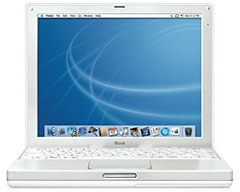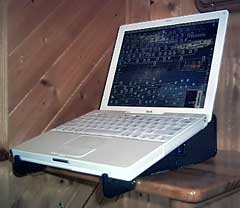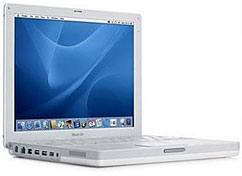Last time, I promised you a Snow Leopard article.
I'm still working on that one, but in the meantime, I just had to write
about another Mac in my collection: the Dual USB iBook.
The Clamshell's successor,
the Dual USB was something completely different. It lost some weight,
and the multiple colors were all gone. Left was only the white
polycarbonate, which is still used in the MacBook and had already been
used in the iMac.
The Dual USB iBook features PowerPC G3 processors from 500 MHz all
the way up to 900 MHz; mine is a 600 MHz version.

Now let's talk about how I made this Classic Mac more useful in the
Intel Age!
My iBook shipped with Mac OS X 10.1 "Puma", which I still have
on the restore CDs. It was quite speedy, but Puma doesn't support many
of the applications we use every day, so I figured I'd go modern and
install Mac OS X 10.4 "Tiger".
I started by checking if the Mac was compatible. It sure was, with a
600 MHz G3, 30 GB hard drive, and 512 MB of RAM. But for some reason,
it refused to install: "Please try installing again." I followed the
installer's advice twice but found myself with the same error
message.
So I started looking into alternatives. The recent "Linux on Macs"
discussion here on Low End Mac got me thinking - maybe Linux could be a
good choice for the iBook.
 All the distributions ("distros")
of Linux made me crazy, but I did remember using Ubuntu on my Celeron
PC two years ago. So I went onto ubuntu.com with my Hackintosh and
downloaded the Ubuntu
7.04 PowerPC image. It took a good 45 minutes to download the image
(slow server?), but once it was finished, I burned it to CD with Disk
Utility.
All the distributions ("distros")
of Linux made me crazy, but I did remember using Ubuntu on my Celeron
PC two years ago. So I went onto ubuntu.com with my Hackintosh and
downloaded the Ubuntu
7.04 PowerPC image. It took a good 45 minutes to download the image
(slow server?), but once it was finished, I burned it to CD with Disk
Utility.
When the image had been burned, I inserted the Ubuntu installer CD
and booted the iBook from it. It took quite some time to boot off the
CD, but eventually I was presented with a Live CD desktop containing an
Install icon.
Believe it or not, Ubuntu also refused to install! I needed this
machine for a trip and was running out of time.
As it turns out, the problem was a faulty RAM stick. I removed the
RAM, but now the iBook had only 128 MB ! That's not enough for Ubuntu,
Tiger, or Panther.
I dug out my Jaguar (Mac OS X 10.2) disks. The iBook booted very
quickly from CD 1, and I chose to do a normal install on the 30 GB
drive. (That drive, by the way, did not ship with the iBook. It came
with a 20 GB drive, but I upgraded.) Would it work?
That question was answered, and the answer was "Yes".
After installing, the good old Jaguar intro movie popped up, and I
had to fill in my personal information.
 Immediately after installing,
I remembered I had a 512 MB stick in an old ThinkPad, so I shut down
the iBook and installed the memory. Jaguar booted extremely fast and
was very, very responsive.
Immediately after installing,
I remembered I had a 512 MB stick in an old ThinkPad, so I shut down
the iBook and installed the memory. Jaguar booted extremely fast and
was very, very responsive.
You might think I'd have wanted to upgrade to Tiger, but no. Jaguar
was so speedy on the iBook, even letting me view DivX and streaming
video, that I simply decided to settle down with it.
And that very iBook still runs Jaguar. It never lets me down, and
I'm always stunned at how this little G3 can be so snappy. Jaguar has
since grown to be my favorite Mac OS X version for G3 computers
(Leopard on newer G4s and G5s, and Tiger on very early G4s).
What do I use the iBook for? Well, since it has AirPort and the
battery is in good shape, I use it on the go to surf the Web and watch
movies. I also use it to edit and create movies in iMovie and for
working with photos in iPhoto. Finally, it occasionally serves as a
media center hooked up to my flat screen TV.
So what's my conclusion? It's that a G3 machine can be quite
powerful and handle more than you think, which is the purpose of this
column - making Classic Macs useful in the Intel Age.
And also that Jaguar is a great operating system for Macs with
limited RAM.
Next time, we'll talk about Snow Leopard.



 All the distributions ("distros")
of Linux made me crazy, but I did remember using Ubuntu on my Celeron
PC two years ago. So I went onto
All the distributions ("distros")
of Linux made me crazy, but I did remember using Ubuntu on my Celeron
PC two years ago. So I went onto  Immediately after installing,
I remembered I had a 512 MB stick in an old ThinkPad, so I shut down
the iBook and installed the memory. Jaguar booted extremely fast and
was very, very responsive.
Immediately after installing,
I remembered I had a 512 MB stick in an old ThinkPad, so I shut down
the iBook and installed the memory. Jaguar booted extremely fast and
was very, very responsive.
